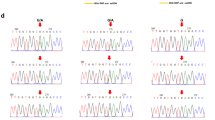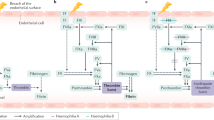Abstract
HAEMOGLOBIN H (Hb H; β4) disease results from a reduced rate of synthesis of the α chains of human adult haemoglobin (Hb A; α2β2). In the absence of sufficient α chains, excess (β chains form β4 tetramers which are unstable, precipitate and cause a shortened red cell survival1. Hb H disease is one of the α-thalassaemia syndromes. These disorders usually result from interactions of three α-thalassaemia (α thal) genes; α thal 1, α thal 2 and Hb Constant Spring. In many human populations the α-chain loci are duplicated, that is, there are two per haploid genome2. The gene α thal 1 results from a deletion of both of the pair of haploid α-chain genes3,4, α thal 2 from a deletion of one of the pair5, and Hb Constant Spring from a chain termination mutation affecting one of the linked loci which markedly reduces the output of α chains and produces a phenotype almost identical to α thal 2(ref. 6). Haemoglobin H disease results from the inheritance of α thal 1 together with either α thal 2 or Hb Constant Spring. There have been occasional reports of an acquired form of Hb H disease occurring in association with leukaemia or related myeloproliferative disorders7–12. We have studied the blood and bone marrow of a patient with acquired Hb H disease and we report here that it has a completely different molecular basis from the genetic form.
This is a preview of subscription content, access via your institution
Access options
Subscribe to this journal
Receive 51 print issues and online access
$199.00 per year
only $3.90 per issue
Buy this article
- Purchase on Springer Link
- Instant access to full article PDF
Prices may be subject to local taxes which are calculated during checkout
Similar content being viewed by others
References
Weatherall, D. J. & Clegg, J. B. The Thalassaemia Syndromes, 2nd edn (Blackwell, Oxford, 1972).
Weatherall, D. J. & Clegg, J. B. Ann. Rev. Genet. 10, 157–78 (1977).
Ottolenghi, S. et al. Nature 251, 389–392 (1974).
Taylor, J. M. et al. Nature 251, 392–393 (1974).
Kan, Y. W. et al. Nature 255, 255–256 (1975).
Weatherall, D. J. & Clegg, J. B. Phil. Trans. R. Soc. 271, 411–455 (1975).
Bergen, W. R. & Sturgeon, P. Proc. 7th Int. Cong. Hematology, 488 (Grune and Stratton, New York, 1960).
White, J. C. et al. Br. J. Haemat. 7, 171–177 (1960).
Beaven, G. H., Stevens, B. L., Dance, N. & White, J. C. Nature 199, 1297–1298 (1963).
Rosenweig, A. I., Heywood, J. D., Motulsky, A. G. & Finch, C. A. Acta haemat. 39, 91–101 (1968).
Hamilton, R. W., Schwartz, E., Atwater, J. & Erslev, A. J. New Engl. J. Med. 285, 1217–1221 (1971).
Pagnier, J., Labie, D. & Schapira, G. Biochimie 55, 1245–1252 (1973).
Weatherall, D. J., Clegg, J. B. & Naughton, M. A. Nature 208, 1061–1065 (1965).
Weatherall, D. J., Clegg, J. B., Na-Nakorn, S. & Wasi, P. Br. J. Haemat. 16, 251–267 (1969).
Clegg, J. B. & Weatherall, D. J. Nature 215, 1241–1243 (1967).
Schwartz, E., Kan, Y. W. & Nathan, D. G. Ann. N. Y. Acad. Sci. 165, 288–294 (1969).
Pritchard, J., Longley, J., Clegg, J. B. & Weatherall, D. J. Br. J. Haemat. 32, 473–486 (1976).
Ottolenghi, S. et al. Cell 9, 71–80 (1976).
Old, J. et al. Cell 8, 13–19 (1976).
Bishop, J. O. & Freeman, K. B. Cold Spring Harb. Symp. quant. Biol. 38, 707–716 (1974).
Weatherall, D. J., Clegg, J. B. & Wong, H. B. Br. J. Haemat. 18, 357–367 (1970).
Weatherall, D. J. et al. Nature 257, 710–712 (1975).
Author information
Authors and Affiliations
Rights and permissions
About this article
Cite this article
OLD, J., LONGLEY, J., WOOD, W. et al. Molecular basis for acquired haemoglobin H disease. Nature 269, 524–525 (1977). https://doi.org/10.1038/269524a0
Received:
Accepted:
Published:
Issue Date:
DOI: https://doi.org/10.1038/269524a0
This article is cited by
Comments
By submitting a comment you agree to abide by our Terms and Community Guidelines. If you find something abusive or that does not comply with our terms or guidelines please flag it as inappropriate.



